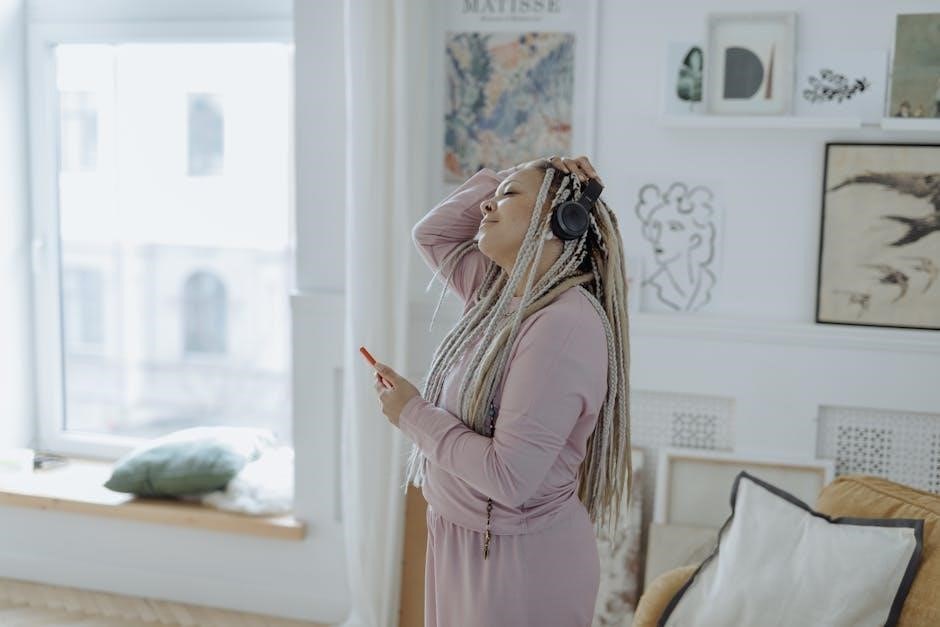A sound wall is a visual tool organizing phonemes, using mouth pictures and exemplar words to enhance phonemic awareness and literacy skills in educational settings.
What is a Sound Wall?
A sound wall is a visual educational tool used to organize and teach phonemic awareness. It typically includes mouth pictures to demonstrate sound articulation, phoneme cards for individual sounds, and exemplar words to provide context. The sound wall is organized by consonants and vowels, helping students understand different sound types and their usage in words. Available as free downloadable PDFs, it offers customizable resources for teachers to enhance literacy skills in the classroom.
Benefits of Using a Sound Wall in Education
A sound wall enhances phonemic awareness by visually linking mouth movements to sounds, aiding students in recognizing and reproducing phonemes. It supports differentiated instruction, catering to visual and kinesthetic learners through mouth pictures and exemplar words. Sound walls foster systematic learning, organizing sounds by articulation, which aligns with how the brain processes language. They also promote engagement, as students can reference real images and mouth placements, making abstract sounds tangible. Additionally, sound walls encourage phonics instruction, helping students decode and spell words effectively. By incorporating sight words, they bridge phonemic awareness with reading skills, creating a comprehensive literacy tool. Overall, sound walls are versatile, adaptable, and effective for diverse learning needs, making them a valuable resource in education.

Components of a Sound Wall
Phoneme Cards with Mouth Pictures
Sound walls include phoneme cards with mouth pictures, showing articulation gestures for each sound, aiding in visual learning and pronunciation guidance.
Exemplar Words and Picture Art
They feature exemplar words and images representing each phoneme, helping students connect sounds to meanings and spellings effectively in educational settings.
Organization by Consonants and Vowels
Sound walls are typically organized by consonants and vowels, making it easier for students to identify and categorize phonemes during literacy activities.
Editable PDF Templates
Many sound wall resources include editable PDF templates, allowing teachers to customize phoneme cards, mouth pictures, and exemplar words for individual classroom needs.
Phoneme cards are a core component of sound walls, providing visual and auditory cues for learning. Each card includes a phoneme, its corresponding mouth picture, and exemplar words. These tools help students connect sounds with articulation, aiding in phonemic awareness and decoding skills. The cards are organized by consonants and vowels, making it easier for students to recognize patterns. Many free PDF resources offer customizable templates, allowing teachers to tailor cards to specific classroom needs. High-quality images of mouth placements ensure clarity, while editable features enable the addition of sight words or personalized examples. This systematic approach supports explicit instruction, making phoneme cards indispensable for literacy development. Teachers can also incorporate real student photos for a more engaging experience, fostering a deeper connection to the learning process.
Exemplar words and corresponding images are central to a sound wall, helping students connect sounds with their spellings and meanings. These visuals, often paired with mouth pictures, provide concrete representations of phonemes, aiding in recognition and articulation. For instance, the short “a” sound might feature words like “cat” or “hat,” accompanied by images of these objects. This combination reinforces phonemic awareness and decoding skills, making abstract sound concepts more tangible for learners. Additionally, real-world images captivate students’ attention, fostering engagement and deeper understanding. Many free PDF resources incorporate editable templates, allowing teachers to customize words and pictures to meet specific classroom needs, ensuring the sound wall remains a dynamic and effective teaching tool.
Sound walls are typically structured by categorizing phonemes into consonants and vowels, providing a clear visual framework for students to explore sounds systematically. This organization helps students recognize patterns in phonemic awareness, linking sounds to their articulation and spellings. Consonants are often grouped by their articulatory features, while vowels are distinguished by mouth shapes and sounds. The inclusion of mouth pictures and exemplar words for each sound enhances understanding, making it easier for learners to connect phonemes with their written forms. This systematic approach fosters a deeper appreciation of the sound system in language, facilitating phonics instruction and reading development. By organizing sounds this way, teachers create a tool that is both educational and engaging for students.

Creating a Sound Wall
Creating a sound wall involves organizing phonemes with mouth pictures and exemplar words, using free PDF templates for customization and effective classroom implementation.
How to Set Up a Classroom Sound Wall
Setting up a classroom sound wall begins with printing and organizing the sound wall PDF, which includes mouth pictures, phoneme cards, and exemplar words. Start by arranging the wall according to consonants and vowels, ensuring clarity for students. Use the mouth photos to demonstrate articulation, placing them alongside corresponding phonemes and words. Add sight words in editable sections for customization. Introduce the wall systematically, beginning with common sounds and building complexity. Encourage student interaction by incorporating real images and personalizing with their own mouth pictures. Regularly update the wall to reflect learning progress, making it a dynamic tool for phonemic awareness and literacy development.
Using Mouth Photos for Articulation
Mouth photos are a key component of sound walls, providing visual cues for proper articulation. These images depict the precise mouth placement for each phoneme, helping students mimic sounds accurately. By associating sounds with visuals, students develop phonemic awareness and improve speech clarity. Teachers can use these photos to demonstrate how lips, tongue, and teeth position for specific sounds, making abstract phonemes tangible; Many sound wall resources, including free PDFs, incorporate these images, often paired with exemplar words and spellings. Additionally, some sets allow customization, enabling teachers to add students’ own mouth pictures for a personalized touch. This visual-kinesthetic approach enhances learning, especially for visual or kinesthetic learners, and supports systematic phonics instruction. Mouth photos also help teachers address articulation challenges effectively, fostering confident and accurate sound production.
Editable PDF Templates for Customization
Editable PDF templates are essential for personalizing sound walls, allowing teachers to tailor resources to their classroom needs. These templates often include mouth photos, phoneme cards, and exemplar words, enabling customization. Teachers can add student-specific images or sight words, making the sound wall more engaging. Many free PDFs, such as the UFLI Sound Wall set, offer editable pages for typing sight words and organizing phonemes; Platforms like Teachers Pay Teachers provide a variety of customizable sound wall templates with mouth articulation art and phoneme cards. These resources empower educators to create a sound wall that aligns with their teaching strategies and student requirements, ensuring a systematic and personalized approach to phonemic awareness and literacy instruction.

Sound Wall Resources
Free Sound Wall PDF Downloads
Discover free sound wall PDFs featuring mouth pictures, phonemes, and exemplar words, ideal for creating engaging literacy tools in the classroom setting.
Teachers Pay Teachers (TpT) Resources
Explore a variety of sound wall resources, including editable templates and lesson guides, to customize phonemic awareness activities for diverse learning needs.
Free sound wall PDF downloads are readily available online, offering educators a cost-effective way to implement phonemic awareness tools in the classroom. These resources often include phoneme cards, mouth pictures, and exemplar words, organized by consonants and vowels. Many downloads provide editable pages, allowing teachers to customize content, such as adding sight words or student-specific articulation photos. Websites like Teachers Pay Teachers and educational blogs offer comprehensive sound wall sets, including mouth articulation art and phoneme cards. These PDFs are designed to be versatile, enabling teachers to create personalized sound walls that cater to individual student needs. By leveraging these free resources, educators can enhance literacy instruction and engagement in their classrooms effectively.
Teachers Pay Teachers offers a wide range of sound wall resources, including phoneme cards, mouth pictures, and editable templates. Many TpT resources provide detailed lesson plans and guides to systematically introduce sound walls in classrooms. Phoneme cards with mouth pictures are popular, helping students connect sounds with articulation. Editable PDFs allow customization, such as adding sight words or student-specific images. The UFLI Sound Wall set is a comprehensive option, featuring 44 phonemes and additional two-phoneme sounds. Resources often include organization tips, exemplar words, and image art to engage students. These materials are designed to support explicit instruction and phonemic awareness, making them invaluable for educators seeking to maximize sound wall effectiveness in their teaching practices.
UFLI Sound Wall Set Overview
The UFLI Sound Wall Set is a comprehensive resource designed to support phonemic awareness and literacy instruction. It includes phoneme cards with mouth pictures, exemplar words, and articulation photos to help students visualize and understand sound production. The set is organized by 44 phonemes and 3 two-phoneme sounds, making it systematic and easy to follow. Teachers can customize the sound wall using editable PDF templates to add sight words or personalized content. The inclusion of mouth articulation photos allows students to see how sounds are formed, enhancing their ability to replicate them. Additionally, the set provides teacher guides and lesson plans for explicit and systematic instruction. This resource is ideal for creating a classroom sound wall that engages students and supports their phonics development. Its flexibility and customization options make it adaptable to various learning environments and needs.

Lesson Plans and Teacher Guides
A comprehensive teacher guide offers systematic lesson plans, phoneme cards, and mouth pictures, supporting explicit instruction and phonemic awareness development in classrooms. Includes editable PDFs for customization and integrating sight words to enhance reading skills.
A systematic introduction to sound walls involves organizing phonemes logically, starting with vowels and progressing to consonants. This approach ensures students build foundational phonemic awareness. Mouth pictures and exemplar words help students connect sounds to articulation and spelling patterns. Teachers can use free PDF resources or purchasable templates from platforms like Teachers Pay Teachers to create customized sound walls. The UFLI Sound Wall set offers comprehensive materials, including phoneme cards and articulation guides. By introducing sounds systematically, educators ensure students understand sound-wall organization, enhancing their ability to decode and spell. This method supports explicit instruction, making phonics instruction clear and engaging for all learners.
- Start with vowel sounds to establish foundational phonemic awareness.
- Use mouth pictures to demonstrate articulation.
- Progress to consonant sounds, grouping them by similarities.
- Incorporate exemplar words and images for context.
Explicit Instruction Strategies
Explicit instruction with sound walls involves systematically introducing phonemes using mouth pictures, exemplar words, and phonemic awareness activities. Teachers can use the UFLI Sound Wall set, which includes phoneme cards with mouth photos, to model articulation and sound production. Free PDF resources, such as editable templates, allow customization for individual needs. Lesson plans guide educators to explicitly teach sound-wall components, ensuring students connect sounds to mouth movements and word examples. This approach enhances decoding and reading comprehension by linking sounds to their visual representations. Teachers can incorporate sight words and real images to engage learners further. By following structured lesson plans, educators ensure consistent and effective instruction, making sound walls a powerful tool for phonemic awareness and literacy development.

Personalizing the Sound Wall
Personalizing sound walls involves adding students’ mouth pictures and customizing for individual needs, making learning engaging and effective with tailored phoneme representations and visual aids.
Adding Student Mouth Pictures
Adding student mouth pictures to a sound wall enhances engagement and personalizes learning. Many free PDF resources include stock mouth photos, but teachers can also take pictures of their students’ mouths to create a more relatable tool. This approach allows students to see how their peers articulate sounds, fostering a sense of classroom community. By incorporating real images, students can better connect their own articulation with the sounds represented on the wall. This customization also helps differentiate instruction, catering to individual learning needs. Personalized mouth pictures make the sound wall more interactive and meaningful, encouraging active participation and ownership of phonemic awareness skills. This feature is particularly effective in making the sound wall a dynamic and student-centered resource for literacy development.
Customizing for Individual Needs
Customizing a sound wall with mouth pictures allows educators to tailor instruction to meet diverse student needs. Teachers can add individual student mouth pictures to create personal connections. Editable PDF templates enable the inclusion of specific sight words, aligning with curriculum goals. The sound wall can be adapted to focus on particular phonemes or sound types, catering to the developmental stage of the class. Additional features like articulation guides and exemplar words provide targeted support for struggling learners. Personalization enhances engagement and ensures that all students can benefit from the sound wall’s structure. This flexibility makes it an invaluable tool for differentiated instruction in literacy education.

Additional Features and Tips

Incorporate high-quality images for better engagement and update the sound wall regularly to reflect students’ progress and expanding phonemic awareness.

Incorporating Sight Words
Incorporating sight words into a sound wall enhances phonemic awareness and decoding skills. Editable PDF templates allow teachers to type sight words, aligning them with corresponding phonemes and mouth pictures. This integration helps students recognize high-frequency words while connecting them to their phonemic representations. Sight words are displayed alongside articulation visuals, making learning engaging and accessible. Teachers can customize sight word lists to match curriculum needs, ensuring relevance and effectiveness. Real images and student mouth pictures further personalize the experience, fostering better engagement and memorization. This approach bridges phonics and sight word recognition, creating a comprehensive literacy tool for diverse learners.

Using Real Images for Better Engagement
Using real images, such as mouth pictures, enhances engagement by providing students with visual cues to connect sounds with articulation. This approach makes phonemic awareness more interactive and accessible. Including real images of students’ mouths or relatable scenarios personalizes the learning experience, making it more relatable and motivating. For instance, pairing mouth pictures with exemplar words and sight words creates a clear connection between sound and spelling. This visual strategy caters to diverse learning styles, ensuring all students can benefit. Real images also help students recognize and mimic articulation, fostering better sound production and language skills. By incorporating authentic visuals, sound walls become dynamic tools that captivate learners and deepen their understanding of phonemic awareness.
The Importance of Mouth Articulation in Learning
Sound walls effectively enhance phonemic awareness and literacy skills, providing clear visual and articulatory cues for students, making them an invaluable educational resource for teachers and learners alike.
Mouth articulation plays a crucial role in learning phonemic awareness, as it visually connects sounds to their physical production. By using mouth pictures, students can observe and mimic the correct placement of lips, tongue, and jaw for each phoneme. This visual and kinesthetic approach enhances understanding and retention, particularly for struggling learners. Sound walls with mouth pictures provide consistent reference points, allowing students to associate sounds with articulation. This method supports early literacy skills, helping learners decode and spell words more effectively. Teachers can further personalize instruction by incorporating students’ own mouth pictures, fostering engagement and ownership of their learning process. This approach ensures that phonemic awareness is both accessible and meaningful, laying a strong foundation for reading and writing success.
Maximizing the Potential of Sound Walls
To fully utilize sound walls, educators can incorporate sight words, ensuring students connect sounds to familiar vocabulary. Using real images enhances engagement, making phonemes relatable. Personalization, such as adding students’ mouth pictures, fosters ownership and motivation. Integrating sound walls into daily lessons through systematic introduction and explicit instruction strategies ensures consistency. Teachers can also customize sound walls with editable PDF templates, tailoring them to specific classroom needs. By leveraging resources like those from Teachers Pay Teachers and the UFLI Sound Wall set, educators can create comprehensive tools that align with curriculum goals. Regular updates and interactive elements keep students engaged, promoting a deeper understanding of phonemic awareness and literacy skills.